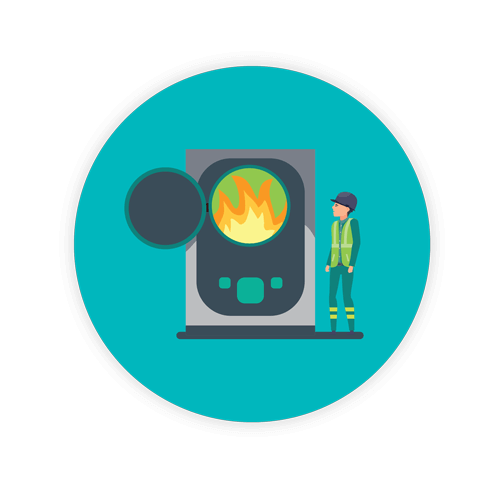How do Hospitals Dispose of their Healthcare Waste?

Depending on volume and type of medical waste generated, hospitals have a number of options when it comes to disposal. On-site as well as off-site options are available to some; however, before medical waste can be transported off the property of a medical waste generator, some of it must be properly treated to reduce or eliminate infectious potential of that waste before it hits the road to its ultimate disposal location.
Two primary options applicable for pre-treatment or destruction for hospitals are incineration or autoclaving, also commonly known as steam sterilization. Both come with pros and cons. determining which is best for your facility depends on the type of medical waste.
TOPICS WE WILL COVER:
1 / Waste Treatment: Autoclave versus Incineration
2 / Hospital Waste Segregation
3 / Wait, What About Clinical Waste?
4 / Generators Responsible for Taking a Cradle-to-Grave Approach
5 / Cost-Effective Hospital Waste Management Solutions
Waste Treatment: Autoclave versus Incineration
Two common methods of disposing of hospital-generated medical waste include incineration or autoclaving.
Incineration is a process that burns medical waste in a controlled environment.
Some hospitals have on-site incineration technology and equipment available. Some don’t. On-site incineration reduces volume of medical waste transported from the facility to a landfill or another disposal site (transported by a medical waste removal company), which can save the generator thousands of dollars per load.
Pre-treatment not only reduces volume of internal medical waste heading to landfills (as non-infectious or decontaminated waste) but also ensures a reduction or complete removal of potentially infectious materials found on a variety of medical waste streams produced by the hospital. State regulations may mandate off-site incineration for certain types of waste. Not all states allow incineration, depending on volume, due to concerns of pollution and damage to air quality.
Autoclaving utilizes heat in the form of steam to sterilize certain types of medical waste, effectively killing microorganisms.
Autoclaves are a type of closed chamber system that use pressure as well as heat or steam to sterilize and destroy microorganisms in some types of medical waste. Autoclaving is commonly used in hospital environments to sterilize medical tools and equipment. It’s also widely used for sharps.
Medical waste placed in an autoclave is exposed to and treated with extremely high temperatures, depending on the size of the autoclave and the amount of medical waste requiring sterilization. As with incinerators, some hospitals are equipped with autoclave equipment while others are not. Hospital autoclaves range in size from a 100-liter to over 4,000 liters of volume.

A variety of additional medical waste treatment examples are applicable to certain medical waste categories such as:
- Chemical – Chemical non-incinerated treatments for medical waste are generally limited to liquid and chemical waste, specifically the type generated in a laboratory environment.
- Irradiation – Also known as microwaving is a treatment that can be used to decontaminate infectious waste and sharps waste.
- Thermal – Typically utilized for infectious waste and sharps waste, but is not recommended for pathological waste.
Hospital Waste Segregation
Know the laws of your state regarding on-site and off-site medical waste segregation and disposal. Daniels Health can help with clarification and healthcare waste management solutions so that you stay compliant.
The Environmental Protection Agency (EPA) provides a number of fact sheets regarding hospital, medical, and infectious waste incinerators. Focus is on emissions and ensuring optimal efficiency while reducing possible pollutants. For example, the EPA has stringent guidelines for adherence to the Clean Air Act (solid waste combustion), Section 129 as well as solid waste incineration guidelines and implementation plans for hospitals.
The EPA also provides specific guidelines in regard to emission standards for hazardous waste combustors, hazardous waste burning incinerators, and requirements mandating that hazardous waste combustor air pollutant emissions standards.
The EPA recommends a cradle-to-grave system in regard to hazardous waste management from the point of origin to final dispensation or disposal. This cycle includes not only segregation of medical waste streams, but transportation of hazardous waste, recycling options, treatment options, and disposal options.
Wait, what about clinical waste?
Clinical waste is a term commonly used by healthcare professionals, but many are surprised to find out that there is not actually a specific meaning to that phrase. Whereas regulated medical waste, biohazardous waste, or biomedical waste are all synonyms referring to any solid waste or liquid waste contaminated with blood, human body fluids, or other materials that could potentially spread infections, clinical waste should not be used interchangeably. Colloquially, it may be used to refer to any waste generated in a clinical setting, but it’s important to know that clinical waste is not a term used within the standard waste management vernacular in the United States.
Generators Responsible for Cradle-to-Grave Approach
Specific regulations apply to hazardous waste generators. Industry specific information regarding very small quantity generatos (VSQs), small quantity generators (SQGs), and large quantity generators (LQGs) are available – all of which must follow applicable standards for each category.
Not only are these regulations a matter of ethical and moral responsibility for the medical waste generator, they are law! Non-compliance results in massive penalties and fines.
For example, according to the EPA, a small quantity generator must not only comply with hazardous waste manifest requirements, but manage their hazardous waste tanks or containers based on regulations found under 40 CFR §262.16 (b)(2)(3).
A large quantity generator can only accumulate waste on-site for up to 90 days, although some exceptions may apply. A large quantity generator doesn’t have a limitation on the volume of hazardous waste accumulated on site, but it must be managed in containment buildings, tanks, containers, or drip pads subject to 40 CFR §262.17 (a)(1)-(4). Land disposal restriction requirements as well as hazardous waste manifest requirements also apply.
All states are required to comply with the Resource Conservation and Recovery Act (RCRA) program, and healthcare waste generators should be aware that state categories as well as regulations may differ from federal regulations, and are often more stringent.
Cost-Effective Hospital Waste Management Solutions
Daniels Health provides hospital-focused healthcare waste disposal and segregation solutions for numerous types of medical waste streams including:
- Sharps disposal
- Pathological waste disposal
- Hazardous waste disposal that adheres to guidelines provided by the RCRA
- Trace Chemotherapy waste and Bulk Chemotherapy Waste disposal
- Pharmaceutical waste disposal (non-hazardous and RCRA Hazardous)
- Waste optimization that benefits waste segregation and saves facilities money while at the same time increasing workplace safety
- Waste Audits, facility-customized education programs and Compliance training
Hospital Waste Compliance is key to saving not only money, but protecting your employees and promoting a clean environment. Partnering with some of the leading clinical brands across the US including Stanford, Rush University and Advent Health, we understand how to navigate the complexity of hospital waste management and drive safety, cost and environmental outcomes. For all your healthcare waste management concerns, contact Daniels Health.
Let's Talk!
Your time is valuable, and we don’t want to play hard to get. You can either phone us directly on the details listed on our contact page, or feel free to fill out this short form and one of our team members will get back to you as quickly as possible.
